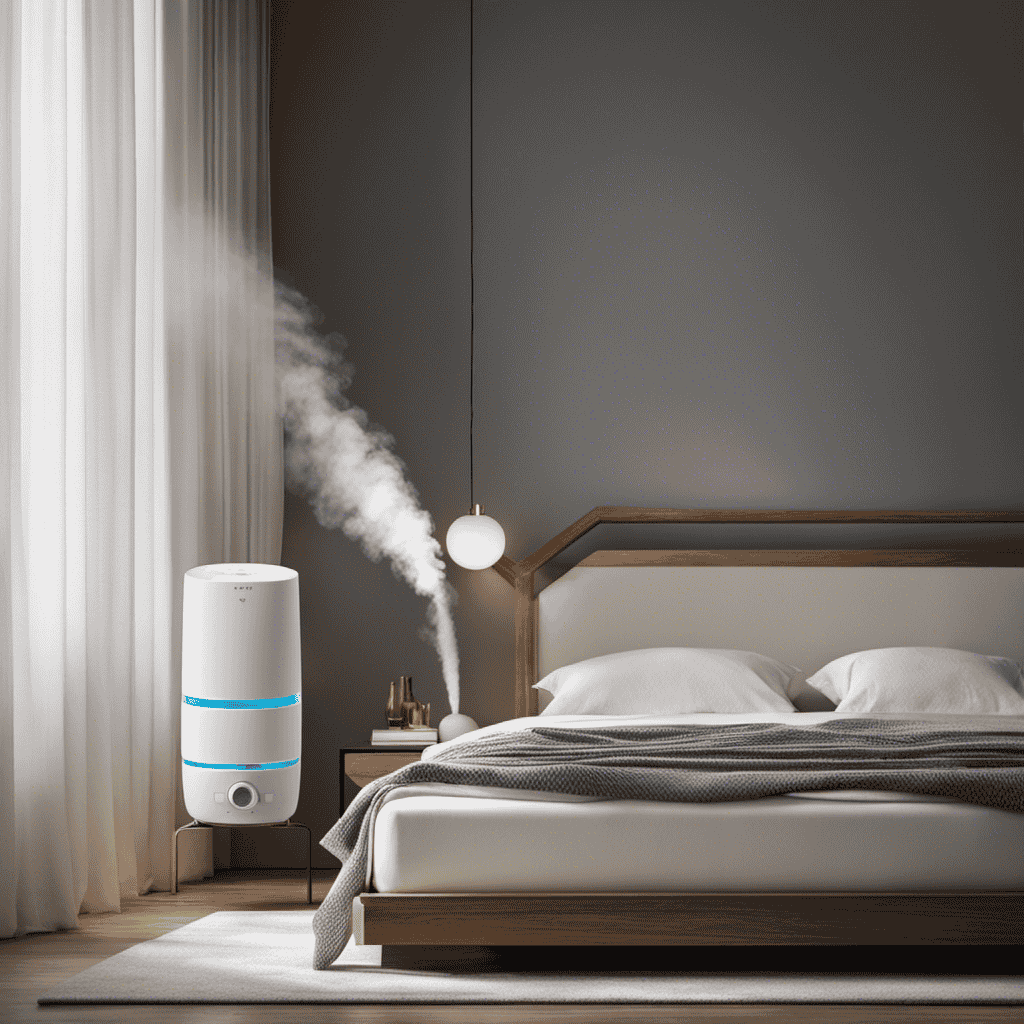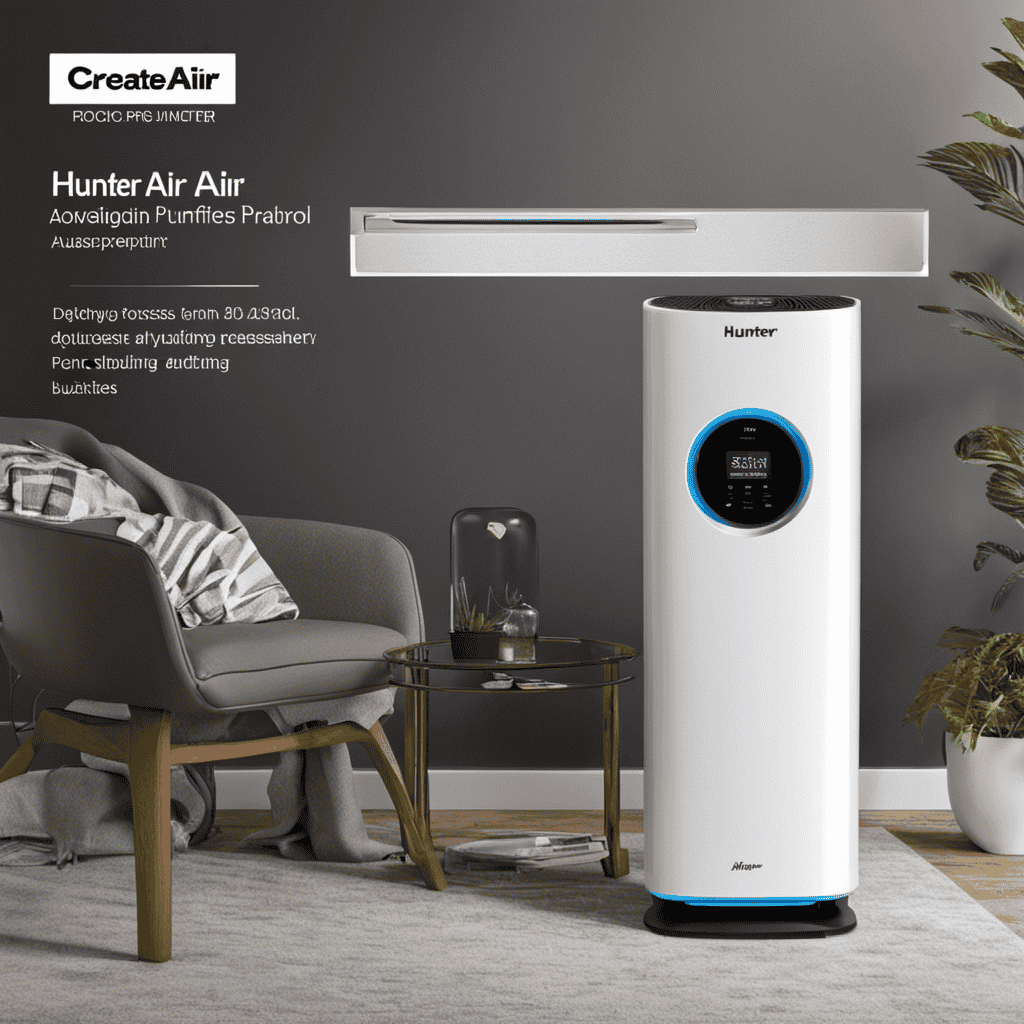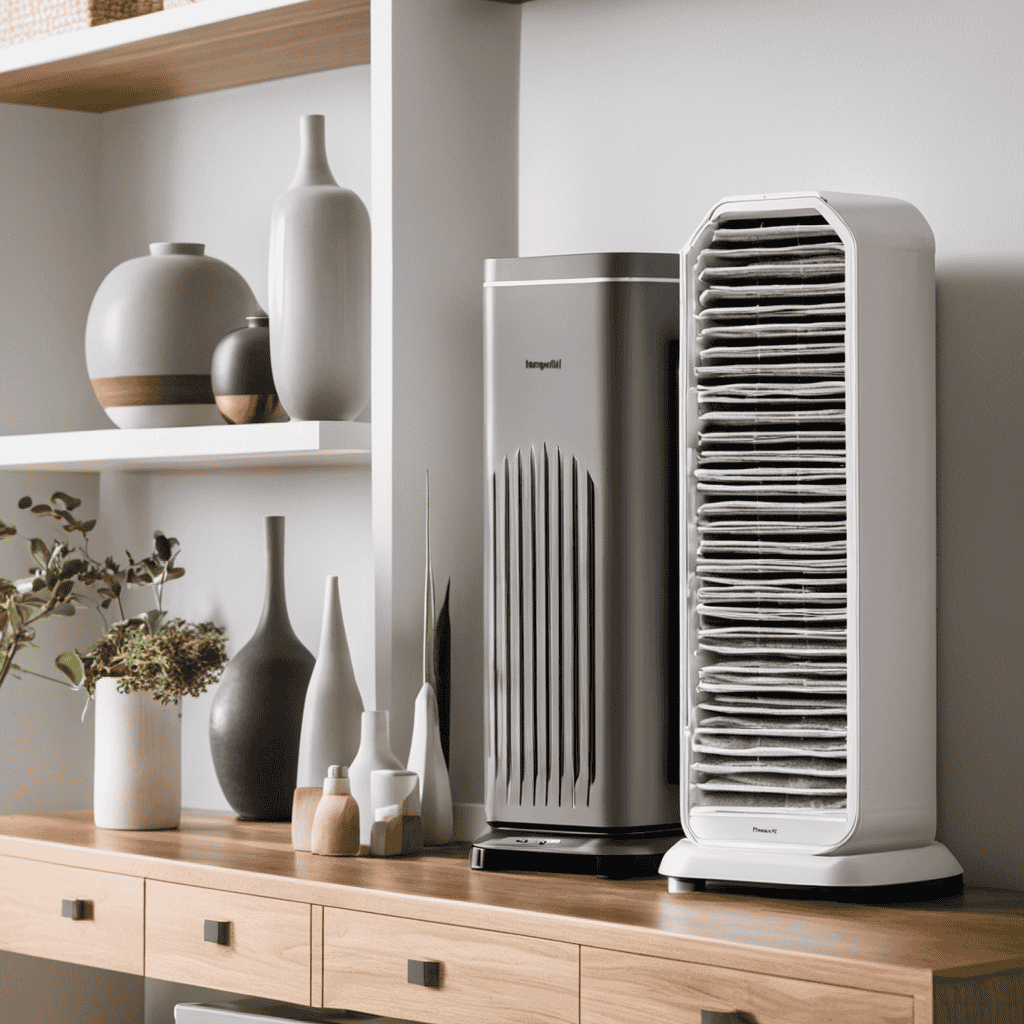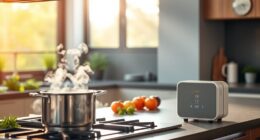I have always been interested in the air we breathe and its impact on our health. That’s why I chose to investigate and write this article on air purifiers.
You see, air purifiers are like little superheroes fighting against invisible enemies in our homes. They use advanced technology to remove harmful particles and pollutants from the air, creating a healthier environment for us to live in.
In this article, I’ll delve into the basics of air purifiers, how they work, their benefits, and much more. So, let’s dive in and discover the world of air purifiers together.
Key Takeaways
- Air purifiers improve indoor air quality by removing pollutants and allergens.
- Different types of air purifiers use mechanisms like HEPA filtration, activated carbon filtration, and UV-C light sterilization to purify the air.
- When buying an air purifier, factors to consider include filter efficiency, CADR rating, noise level, and maintenance requirements.
- Clean air is important for reducing the risk of respiratory diseases, improving immune function, boosting mental health, and maintaining overall well-being.
Understanding the Basics of Air Purifiers
To understand the basics of air purifiers, you’ll need to know how they work and what types are available.
Air purifiers are designed to improve indoor air quality by removing pollutants and allergens from the air. They work by drawing in air and passing it through a series of filters that capture particles such as dust, pollen, pet dander, and smoke.
The effectiveness of an air purifier depends on the type of filter it uses and the size of the room it is placed in. Regular air purifier maintenance is important to ensure optimal performance. This includes cleaning or replacing filters, as well as regularly cleaning the unit itself.
How Air Purifiers Work
Air purification is a crucial aspect in maintaining clean and healthy indoor air.
Understanding the mechanisms behind air filtration can help us make more informed decisions when it comes to choosing the right air purifier for our needs.
Air Filtration Mechanisms
You should know that air purifiers use various mechanisms to filter out impurities from the air. These mechanisms are designed to enhance the effectiveness of air purifiers and mitigate the impact of air pollution.
Here are three key mechanisms used in air filtration:
-
HEPA Filtration: High Efficiency Particulate Air (HEPA) filters are widely recognized for their ability to remove microscopic particles like dust, pollen, and pet dander from the air. With their dense fiber structure, HEPA filters can capture particles as small as 0.3 microns, ensuring cleaner and healthier air.
-
Activated Carbon Filtration: Activated carbon filters excel in eliminating odors, volatile organic compounds (VOCs), and harmful gases. The carbon material has a large surface area that can absorb and trap these impurities, effectively improving the air quality in your surroundings.
-
UV-C Light Sterilization: UV-C light is used in air purifiers to kill airborne bacteria, viruses, and mold spores. When the air passes through the purifier, the UV-C light damages the DNA or RNA of these microorganisms, rendering them unable to reproduce and causing them to die off.
With these air filtration mechanisms in place, air purifiers play a crucial role in purifying indoor air and creating a healthier living environment for you and your loved ones.
Purifying Indoor Air
Indoor air can be purified effectively using mechanisms like HEPA filtration, activated carbon filtration, and UV-C light sterilization. As someone concerned about the air quality in my office, I wanted to understand how these mechanisms work and which air purifiers are suitable for office spaces. HEPA filters, or High-Efficiency Particulate Air filters, are highly effective in removing small particles such as dust, pollen, and pet dander from the air. Activated carbon filtration helps eliminate odors, chemicals, and volatile organic compounds (VOCs). UV-C light sterilization kills bacteria and viruses by breaking down their DNA. To make it easier to compare different air purifiers, I created a table with three columns and five rows. This way, I could easily compare the features, filtration methods, and room coverage of various air purifiers designed for office use.
| Air Purifier Model | Filtration Methods | Room Coverage |
|---|---|---|
| Model A | HEPA, Activated Carbon | 300 sq ft |
| Model B | HEPA, UV-C Light | 500 sq ft |
| Model C | HEPA, Activated Carbon, UV-C Light | 800 sq ft |
| Model D | HEPA, UV-C Light, Activated Carbon | 400 sq ft |
| Model E | HEPA, Activated Carbon | 250 sq ft |
Understanding the benefits and capabilities of different air purifiers helps me make an informed decision on which one to choose for my office. By selecting an air purifier that incorporates HEPA filtration, activated carbon filtration, and UV-C light sterilization, I can ensure that the indoor air in my office is clean and free from harmful pollutants.
Benefits of Using an Air Purifier
One of the benefits of using an air purifier is that it can help reduce allergens in your home. Air purifiers use advanced technology to filter out particles and pollutants from the air, creating a cleaner and healthier environment.
Here are three reasons why investing in an air purifier is worth considering:
-
Improved Indoor Air Quality: Air purifiers capture and remove allergens such as dust, pet dander, pollen, and mold spores, reducing the risk of allergies and respiratory issues.
-
Odor Elimination: Air purifiers can eliminate unpleasant odors by trapping and neutralizing odor-causing particles, leaving your home smelling fresh and clean.
-
Reduced Asthma and Allergy Symptoms: By removing common triggers for asthma and allergies, air purifiers can help alleviate symptoms, allowing you to breathe easier and enjoy a more comfortable living space.
Regular maintenance, such as replacing filters and cleaning the unit, is essential to ensure optimal performance and longevity of your air purifier.
Types of Air Purifiers
Now that we know the benefits of using an air purifier, let’s dive into the different types of air purifiers available on the market. It’s important to understand the options before making a decision on what best suits your needs. Below is a table showcasing five popular types of air purifiers and their features:
| Type of Air Purifier | Features |
|---|---|
| HEPA Air Purifier | Removes 99.97% of particles as small as 0.3 microns |
| Activated Carbon Air Purifier | Absorbs odors and chemicals through activated carbon filters |
| UV Air Purifier | Uses ultraviolet light to kill bacteria and viruses |
| Ionic Air Purifier | Emits negative ions to attach to and remove airborne particles |
| Ozone Generator | Produces ozone to eliminate odors, mold, and bacteria |
Now that we understand the different types of air purifiers, it’s essential to discuss air purifier maintenance and the best air purifier brands. This information will help us make an informed decision when choosing the right air purifier for our needs.
Choosing the Right Air Purifier for Your Needs
To find the right air purifier for your needs, it’s important to consider factors such as room size, specific air quality concerns, and budget. Here are three key factors to consider when selecting an air purifier:
-
Filter Efficiency: Look for an air purifier with a high-efficiency particulate air (HEPA) filter. This type of filter can capture particles as small as 0.3 microns, including dust, pollen, pet dander, and mold spores. It is crucial for maintaining clean and healthy indoor air.
-
CADR Rating: The Clean Air Delivery Rate (CADR) measures the effectiveness of an air purifier in removing smoke, dust, and pollen from the air. A higher CADR rating means the unit can clean the air faster and more efficiently.
-
Noise Level: Consider the noise level of the air purifier, especially if you plan to use it in your bedroom or office. Look for a model with a low noise level to ensure a peaceful and undisturbed environment.
Common Features of Air Purifiers
Consider the size of the room and the specific air quality concerns you have when choosing an air purifier.
The maintenance of an air purifier is an important aspect to consider. Regular cleaning and filter replacement are essential for optimal performance. Dust and debris can accumulate in the filters, reducing their effectiveness over time. Some air purifiers have indicator lights that alert you when it’s time to clean or replace the filters.
Noise levels are another factor to consider. Air purifiers with higher fan speeds tend to be noisier. If you’re sensitive to noise, look for models with adjustable fan speeds or a quiet mode. It’s important to find a balance between effective air purification and acceptable noise levels for your specific needs.
The Importance of Clean Air in Your Home
Clean air is essential for maintaining good health as it can have numerous benefits on our well-being. Breathing in clean air helps to reduce the risk of respiratory diseases, such as asthma and allergies. Additionally, clean air can improve our immune system, enhance lung function, and even boost our mental health.
However, it is important to be aware of the sources of indoor air pollution, such as tobacco smoke, mold, and chemicals from household products, as they can significantly affect the air quality in our homes.
Health Benefits of Clean Air
Breathing in clean air can have several health benefits, such as reducing the risk of respiratory illnesses. Here are three ways clean air can positively impact your health:
-
Improved lung function: Clean air free from pollutants allows your lungs to function optimally, enabling you to breathe easier and with greater efficiency. This can enhance your overall respiratory health and reduce the risk of developing chronic respiratory conditions like asthma or bronchitis.
-
Boosted immune system: When you breathe in clean air, your immune system becomes stronger and more resilient. This helps your body fight off infections, viruses, and other harmful pathogens, reducing the likelihood of falling ill and improving your overall well-being.
-
Enhanced mental clarity: Clean air is not only beneficial for your physical health but also for your mental well-being. Breathing in fresh, clean air can increase oxygen levels in your brain, improving your cognitive function, focus, and overall mental clarity.
Indoor Air Pollution Sources
When it comes to maintaining indoor air quality, it’s important to be aware of the various sources of pollution. Indoor air pollution can arise from a variety of sources, including chemicals, biological contaminants, and particulate matter. These pollutants can have a significant impact on our health, causing respiratory problems, allergies, and even more serious conditions. To help combat indoor air pollution, many people turn to air purifiers. These devices work by filtering out harmful particles and pollutants from the air, improving overall air quality. However, it’s important to note that the effectiveness of air purifiers can vary depending on factors such as the size of the room and the type of pollutants present. Therefore, it’s crucial to choose the right air purifier for your specific needs to maximize its effectiveness in improving indoor air quality and minimizing the negative impact of indoor air pollution on your health.
| Sources of Indoor Air Pollution | Effects on Health |
|---|---|
| Chemicals (Cleaning products, | Respiratory problems |
| paints, furniture) | Allergies |
| Biological contaminants | Asthma |
| (Mold, pollen, pet dander) | Lung diseases |
| Particulate matter | Cardiovascular issues |
| (Dust, smoke, PM2.5) | Increased risk of respiratory |
| infections |
Factors to Consider When Buying an Air Purifier
Before purchasing an air purifier, you should take into consideration factors such as the size of the room and the specific pollutants you want to target. These factors will help you determine the right type and size of air purifier for your needs.
Here are three features to look for when buying an air purifier:
-
Filter efficiency: Look for an air purifier with a high-efficiency particulate air (HEPA) filter. HEPA filters are capable of capturing 99.97% of particles as small as 0.3 microns, including allergens, dust, and pet dander.
-
CADR rating: The Clean Air Delivery Rate (CADR) measures how quickly an air purifier can clean the air in a given room size. Look for an air purifier with a CADR rating that matches or exceeds the size of your room.
-
Noise level: Consider the noise level of the air purifier, especially if you plan to use it in a bedroom or office. Look for a model with a low noise level, so it doesn’t disturb your sleep or work.
How Often Should You Use an Air Purifier
When it comes to using an air purifier, it is important to consider the optimal usage frequency.
Regular use of an air purifier can provide numerous benefits, such as reducing allergens, improving air quality, and promoting better respiratory health.
However, overusing an air purifier can have potential drawbacks, including increased energy consumption and the possibility of creating an overly sterile environment.
Optimal Usage Frequency
The optimal usage frequency for an air purifier varies depending on the size of the room. To ensure the best air quality, it is important to understand the recommended usage duration and maintenance schedule.
Here are three key factors to consider:
-
Room Size: Larger rooms require more frequent usage to effectively purify the air. Smaller rooms may only need a few hours of usage per day.
-
Indoor Pollution Levels: If you live in an area with high pollution levels or have pets or smokers in your home, you may need to use the air purifier more frequently to maintain clean air.
-
Allergies and Asthma: Individuals with allergies or asthma may benefit from continuous usage of an air purifier to reduce allergens and irritants in the air.
Benefits of Regular Use
In my previous discussion about the optimal usage frequency of air purifiers, it became clear that regular use is essential for maintaining clean indoor air.
Now, let’s delve deeper into the benefits of using air purifiers regularly and how it can positively impact our respiratory health.
Regular use of air purifiers ensures that the air we breathe is free from pollutants and allergens. These devices employ various cleaning techniques, such as HEPA filtration, activated carbon, and UV-C light, to capture and eliminate harmful particles from the air. By removing airborne contaminants like dust, pet dander, pollen, and mold spores, air purifiers reduce the risk of respiratory issues, such as allergies, asthma, and respiratory infections.
Furthermore, air purifiers can help alleviate symptoms for individuals already suffering from respiratory conditions. By removing irritants from the air, these devices create a cleaner and healthier environment, reducing the frequency and severity of respiratory symptoms.
Potential Drawbacks of Overuse?
To avoid potential drawbacks, you should be mindful of not overusing air purifiers as excessive filtration can lead to reduced humidity levels in your home.
While air purifiers are incredibly beneficial for improving indoor air quality, using them excessively can have negative consequences. Here are three potential health risks and overuse consequences to consider:
-
Dryness and irritation: Overusing air purifiers can result in reduced humidity levels, leading to dry skin, irritated eyes, and respiratory discomfort.
-
Increased energy consumption: Running air purifiers continuously can significantly increase your energy consumption, resulting in higher electricity bills.
-
Reduced effectiveness: Continuous filtration can cause the air purifier’s filters to become overloaded, reducing their effectiveness in capturing pollutants and allergens.
To ensure the optimal performance of your air purifier and prevent potential health risks, it is vital to regularly maintain and clean your device.
Maintaining and Cleaning Your Air Purifier
Make sure you regularly clean and maintain your air purifier to ensure it functions properly. Cleaning techniques and maintenance tips are crucial for keeping your air purifier in top-notch condition.
Firstly, it’s important to clean or replace the filters regularly. Most air purifiers have a pre-filter that can be vacuumed or washed, while the HEPA filter usually needs to be replaced every six months to a year.
Additionally, wipe down the exterior of the purifier with a damp cloth to remove any dust or dirt buildup. It’s also recommended to clean the air intake vents and grilles to prevent blockage.
Lastly, don’t forget to check the manufacturer’s instructions for specific cleaning and maintenance guidelines. By following these techniques and tips, you can ensure that your air purifier remains efficient in purifying the air in your home.
Can Air Purifiers Help With Allergies
After learning about how to maintain and clean my air purifier, I wanted to explore whether air purifiers could help with allergies. As someone who suffers from pollen and dust mite allergies, I was eager to find a solution to alleviate my symptoms.
Here are three ways air purifiers can help:
-
Capture Pollen Particles: Air purifiers equipped with HEPA filters can effectively trap pollen particles in the air, reducing the amount that enters our respiratory system.
-
Eliminate Dust Mites: Air purifiers with HEPA filters can also capture and remove dust mite allergens from the air, helping to reduce allergic reactions.
-
Improve Indoor Air Quality: By continuously circulating and filtering the air, air purifiers can reduce the overall levels of allergens, such as pollen and dust mites, in our homes, providing relief for allergy sufferers.
With these benefits in mind, investing in an air purifier designed for pollen and dust mite allergies could greatly improve the quality of life for allergy sufferers like myself.
Air Purifiers Vs. Humidifiers: What’s the Difference
When it comes to comparing air purifiers and humidifiers, it’s important to understand their purpose and functionality.
Air purifiers are designed to remove pollutants and allergens from the air.
Humidifiers, on the other hand, add moisture to the air to alleviate dryness.
While both devices can have health benefits, such as improving air quality and reducing respiratory symptoms, they also have drawbacks.
These drawbacks include the need for regular maintenance and the potential for over-humidifying the air.
Purpose and Functionality
The purpose of an air purifier is to remove harmful particles and pollutants from the air, improving indoor air quality. Understanding air purification technology is crucial in evaluating the effectiveness of air purifiers in different environments.
Here are three key factors to consider:
-
Filter Efficiency: The quality of filters used in an air purifier determines its effectiveness. High-efficiency particulate air (HEPA) filters are considered the gold standard, as they can capture particles as small as 0.3 microns with an efficiency of 99.97%.
-
CADR Rating: Clean Air Delivery Rate (CADR) measures how quickly an air purifier can remove pollutants from the air. Higher CADR ratings imply faster and more efficient purification.
-
Room Size: Air purifiers are designed to work within specific room sizes. It is essential to choose a purifier that matches the square footage of your space for optimal performance.
Considering these factors will help you select the right air purifier for your specific needs, ensuring clean and healthy indoor air.
Health Benefits and Drawbacks?
To determine if an air purifier is the right choice for you, it is important to consider the health benefits and drawbacks.
Air purifiers can help improve indoor air quality by removing pollutants such as dust, pollen, pet dander, and mold spores. This can be particularly beneficial for individuals with allergies or respiratory conditions.
However, it is essential to be aware of potential risks and long-term effects. Some air purifiers generate ozone as a byproduct, which can be harmful to the lungs and worsen respiratory symptoms. Additionally, certain types of air purifiers may produce harmful byproducts, such as formaldehyde or other volatile organic compounds.
It is crucial to carefully research and choose an air purifier that meets your specific needs and does not pose any potential risks or long-term health effects.
Air Purifiers for Pet Owners: What You Need to Know
Air purifiers can be beneficial for pet owners because they help to remove pet dander and other allergens from the air. As a pet owner myself, I understand the struggle of dealing with allergies caused by our furry friends. Here are three reasons why air purifiers are a must-have for pet owners:
-
Reduction of Pet Allergens: Air purifiers with HEPA filters effectively capture pet dander and other allergens, making it easier for those with allergies to breathe freely in their own homes.
-
Odor Elimination: Air purifiers equipped with activated carbon filters can help eliminate unpleasant pet odors, leaving your home smelling fresh and clean.
-
Improved Indoor Air Quality: By removing pet hair, dust, and other particles from the air, air purifiers create a healthier environment for both you and your pets.
Transition: Now that we’ve discussed the benefits for pet owners, let’s move on to exploring air purifiers for people with asthma in our next section.
Air Purifiers for People With Asthma: a Guide
Now that we’ve covered the benefits for pet owners, let’s delve into air purifiers for individuals with asthma.
Air purifiers can be a valuable tool for those with asthma, as they help remove airborne allergens and pollutants that can trigger asthma symptoms. When considering air purifiers for asthma, it’s important to look for models that have a high-efficiency particulate air (HEPA) filter, as these filters are capable of capturing small particles like pollen, dust mites, and pet dander.
Additionally, air purifiers with activated carbon filters can help remove odors and chemicals, making them beneficial for individuals with asthma who may also be sensitive to certain smells. It’s worth noting that while air purifiers can be helpful for asthma management, they should not be considered a standalone treatment and should be used in conjunction with other asthma management strategies.
As for air purifiers for smokers, they can help remove smoke particles from the air, but they may not be able to eliminate all the harmful chemicals associated with smoking. It’s important for smokers to quit smoking for their overall health.
When it comes to air purifiers for children, it’s crucial to choose models that are safe and do not emit harmful ozone. Look for air purifiers that are certified by reputable organizations and have child-friendly features like a child lock or tamper-proof settings.
In conclusion, air purifiers can be beneficial for individuals with asthma, but they should be used as part of a comprehensive asthma management plan.
Now, let’s explore the future of air purifiers and what we can expect in terms of advancements and innovations in this field.
The Future of Air Purifiers: What to Expect
In the future, we can anticipate advancements and innovations in the field of air purification. As technology continues to evolve, air purifiers will become more sophisticated and efficient, offering improved performance and a wider range of features.
Here are three exciting developments we can expect:
-
Smaller and more portable designs: Future air purifiers will be compact and lightweight, making them easier to move around and place in any room. This will provide greater convenience and flexibility for users.
-
Smart and connected features: Air purifiers will integrate with smart home systems, allowing users to control and monitor air quality remotely. They will also have sensors that can detect pollutants and adjust settings accordingly, ensuring optimal purification.
-
Environmentally friendly solutions: With a growing focus on sustainability, future air purifiers will incorporate eco-friendly materials and technologies. They will have low energy consumption and use advanced filtration systems that remove harmful pollutants without producing harmful by-products.
These advancements will not only improve indoor air quality but also have a positive impact on the environment.
How Does an Air Purifier Work?
Air purifier benefits and functions by removing contaminants from the air through a filtration system. The device draws in air, traps particles such as dust and pollen, and then releases clean, fresh air back into the room. Some models also use UV light or ionizers to neutralize airborne pathogens.
Frequently Asked Questions
Are Air Purifiers Safe for Children and Pets?
Yes, air purifiers are safe for children and pets. They can help reduce allergens and pollutants in the air, making it easier for those with allergies or asthma to breathe.
Can Air Purifiers Remove Cigarette Smoke and Odors?
Yes, air purifiers can effectively remove cigarette smoke and odors. They work by filtering the air and capturing the harmful particles. This is one of the many benefits of using an air purifier, especially for those with allergies.
How Much Noise Do Air Purifiers Make?
Air purifiers can make different levels of noise depending on the model and settings. Regular maintenance, such as cleaning or replacing filters, can help reduce noise. The benefits of using air purifiers include improved indoor air quality and reduced allergens.
Do Air Purifiers Help With Mold and Mildew?
Yes, air purifiers can help with mold and mildew prevention by filtering out airborne mold spores. They improve indoor air quality by removing pollutants and allergens, reducing the risk of mold growth.
Can Air Purifiers Reduce the Spread of Viruses and Bacteria?
Yes, air purifiers can help reduce the spread of viruses and bacteria. They work by filtering the air and capturing these harmful particles, improving indoor air quality and reducing the risk of allergies and respiratory infections.
Conclusion
In conclusion, air purifiers are an essential tool for improving indoor air quality and promoting better health. By effectively removing pollutants, allergens, and odors from the air we breathe, air purifiers create a cleaner and healthier living environment.
One real-life example of the benefits of an air purifier is a case study where a family with a newborn baby experienced a significant reduction in respiratory symptoms and improved sleep quality after using an air purifier in their nursery. This highlights the powerful impact that air purifiers can have on our well-being.
As technology continues to advance, we can expect even more innovative features and improved performance from air purifiers in the future.










